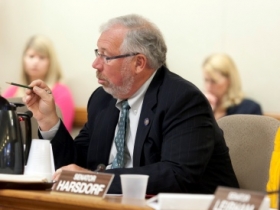How School Choice Got Expanded Statewide
Deal by GOP legislators and pushed by voucher lobbyists expanded it beyond Gov. Walker's proposal.
How did Gov. Scott Walker’s February plan to expand School Choice to private schools in nine specific school districts morph into the plan, which became law, to expand Choice statewide, subject to a 500-student limit this school year (outside of Milwaukee and Racine)?
Interviews last week shed some light on the backroom decision to expand Choice statewide, subject to enrollment caps. That means the governor and legislators elected in November 2014 will have to act to stop Choice from going statewide– with no enrollment limit — in the 2015-16 school year.
In a WisconsinEye interview, the chairs of the Senate and Assembly education committees – Republican Sen. Luther Olsen, of Ripon, and Republican Rep. Steve Kestell, of Elkhart Lake – listed these reasons why Choice was expanded beyond the nine districts Walker first proposed:
*Walker based his request to expand Choice to nine more districts (in addition to Milwaukee and Racine) on the first school-by-school “report cards” issued by the State Department of Public Instruction. He also proposed the 500-student limit on new Choice students.
But Olsen said that misused the report cards, which he, Kestell and Public Instruction Supt. Tony Evers helped design. Walker ignored his request to not use the report cards to pick Choice expansion districts, Olsen said.
Olsen said the report cards should measure school-by-school improvements, or failures, and were “not designed to make a (Choice) funding decision.”
*Kestell said a statewide expansion of Choice, with a 500-student limit this school year, and 1,000-student limit in the 2014-15 school year, was “fairer.”
Had Choice expanded to the nine districts Walker proposed, some of those districts would have seen a “real big” loss of students to private schools, Kestell added. Because so many students applied to attend private schools at state expense, DPI are picking winners by lottery.
*The 500- and 1,000-student limits on Choice expansion control costs – for now.
Private schools outside Milwaukee and Racine chosen to participate in Choice will be paid between $6,442 per student, which is money state government can afford.
Olsen and Kestell are troubled that most students who applied for Choice expansion attended private schools last year. “I don’t think (Choice) was designed to pay for kids that were already going into the private school system,” Olsen said.
*Four current and former Assembly Republican speakers were lobbying for Choice to go statewide, and jumped at a chance to accept the 500- and 1,000-student limits for two years because it lays the groundwork for an unlimited statewide Choice program in 2015-16.
Assembly Speaker Robin Vos has said he favors an unlimited statewide Choice program “tomorrow,” so he was immediately open to broadening Walker’s nine-district offer.
Three other former Assembly speakers – Republicans Jeff Fitzgerald (20011-12), John Gard (2003-04) and Scott Jensen (1997-2002) – were also pushing to expand Choice statewide.
And the president of School Choice Wisconsin is Jim Bender, a former senior Assembly GOP aide.
Their lobbying clout meant that the Assembly was willing to go much, much farther to expand Choice than Walker asked in February. The problem was Senate Republicans, led by Olsen and Senate President Mike Ellis, who two years ago blocked expanding Choice to Green Bay.
Assembly Republicans held fast: “There won’t be a final deal on new state budget unless it expands Choice. So, you Republican senators make us an offer to expand Choice we can accept.”
That’s when the 18 Senate Republicans decided on a new approach: Let’s dump Walker’s plan to list specific public school districts – Green Bay, Beloit, Madison, for example — where Choice can expand. Instead, let’s agree to the 500-school limit and let parents, private schools and DPI sort out the details.
Pro-choice lobbyists were ecstatic at the senators’ compromise. It will expand Choice to private schools in cities that weren’t on Walker’s original list. And, if Republicans control the Capitol two years from, enrollment caps can be eliminated in the 2015-17 budget.
The State of Politics
-
A Wisconsin Political Trivia Quiz
 Dec 15th, 2025 by Steven Walters
Dec 15th, 2025 by Steven Walters
-
The Fight Over Wisconsin’s House Districts
 Dec 8th, 2025 by Steven Walters
Dec 8th, 2025 by Steven Walters
-
The Battle Over On-Line Betting
 Nov 24th, 2025 by Steven Walters
Nov 24th, 2025 by Steven Walters



















